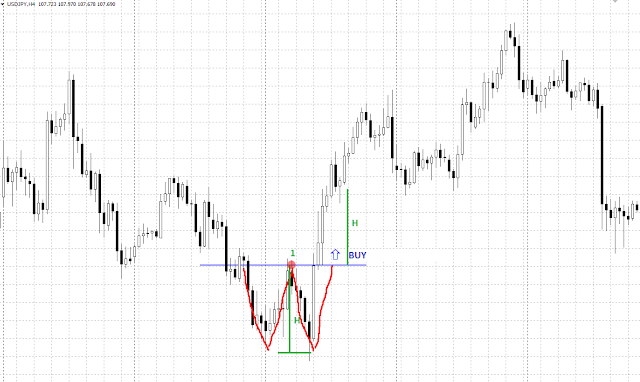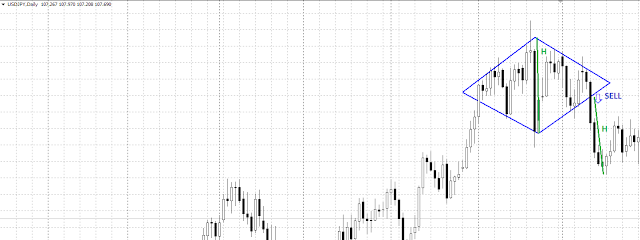A pattern means a repeated element in different spheres of life – nature, psychology, music, design, trading, etc. When it comes to trading, a pattern is a stable and repeated combination of data on prices, volumes, or indicators.
What is a chart pattern in tech analysis?
Chart patterns are specific and repeated areas on the price charts and sometimes they are called price patterns or formations.
Over the years of monitoring financial markets, it was noticed that from time to time the price charts showed chart patterns (or price patterns), which might be used to predict further movements. There are patterns that indicate the reverse of tendencies and there are formations that show their continuation. Here, it would be important to note that formation of price patterns on charts does not 100% mean that the price will move as these patterns predict, but there is a possibility of matching and may help in trading.
Head & Shoulders and Inverted Head & Shoulders chart patterns
These are reversal patterns, which are usually formed at local lows and highs of the price chart within either ascending or descending trend. The patterns indicate that the current tendency is getting weaker and the price is expected to either start a correction or reverse the tendency to the opposite side.
1. Head & Shoulders
Head & Shoulders chart pattern is formed at highs within an ascending tendency. A bottom line is drawn through 1 and 2 (neckline). The chart pattern is considered completely formed only after the price fixes below the bottom line. After that, the price is expected to fall by the distance equal to, at least, the pattern height, which is measured in pips from the pattern’s high to the neckline. One is recommended to sell right when the price breaks the bottom line or wait until it returns to the line after breaking it.
2. Inverted Head & Shoulders
Inverted Head & Shoulders chart pattern is formed at lows within a descending tendency. A bottom line is drawn through 1 and 2 (neckline). The chart pattern is considered completely formed only after the price fixes above the bottom line. After that, the price is expected to grow by the distance equal to, at least, the pattern height, which is measured in pips from the pattern’s low to the neckline. One is recommended to buy right when the price breaks the bottom line or wait until it returns to the line after breaking it.
Double Top and Double Bottom chart patterns
These are reversal chart patterns, which are usually formed at local lows and highs of the price chart within either ascending or descending trend. The patterns indicate that the current tendency is getting weaker and the price is expected to either start a correction or reverse the tendency to the opposite side.
3. Double Top
Double Top chart pattern is formed at highs within an ascending tendency. A horizontal bottom line is drawn through 1. The chart pattern is considered completely formed only after the price fixes below the bottom line. After that, the price is expected to fall by the distance equal to, at least, the pattern height, which is measured in pips from the pattern’s highs to the bottom line. One is recommended to sell right when the price breaks the bottom line or wait until it returns to the line after breaking it.
4. Double Bottom
Double Bottom chart pattern is formed at lows within a descending tendency. A horizontal bottom line is drawn through 1. The chart pattern is considered completely formed only after the price fixes above the bottom line. After that, the price is expected to grow by the distance equal to, at least, the pattern height, which is measured in pips from the pattern’s lows to the bottom line. One is recommended to buy right when the price breaks the bottom line or wait until it returns to the line after breaking it.
Triple Top pattern
Triple Bottom pattern
7. Wedge chart pattern
Wedge chart pattern is a reversal chart pattern, which is formed at highs and lows between two convergent lines, support and resistance. The chart pattern has some similar features of Triangle with the key distinction being skew angle (of both lines forming it) in the same direction. Wedge is considered broken when the price leaves the chart pattern in the direction that is opposite to the skew. If Wedge is formed at highs within an ascending tendency, one is recommended to sell after the price fixes below the support line; the target of the chart pattern is the value of the chart pattern’s base (H) in pips. If Wedge is formed at lows within a descending tendency, one is recommended to buy after the price fixes above the resistance line; the target of the chart pattern is the value of the chart pattern’s base (H) in pips.
Wedge chart pattern
8. Diamond chart pattern
Quite rare reversal chart pattern in the form of a Diamond. It is formed at local highs and lows of the price chart within either ascending or descending trend. The chart patterns indicate that the current tendency is getting weaker and the price is expected to either start a correction or reverse the tendency to the opposite side. If Diamond is formed at highs within an ascending tendency, one is recommended to sell after the price fixes below the support line; the target of the chart pattern is the chart pattern’s height (H) in pips. If Diamond is formed at lows within a descending tendency, one is recommended to buy after the price fixes above the resistance line; the target of the chart pattern is the chart pattern’s height (H) in pips.
Diamond chart pattern
9. Rectangle chart pattern
Rectangle chart pattern is a universal chart pattern that may predict both a reverse and a continuation of an actual tendency. It looks like a sideways channel formed by horizontal support and resistance level, where the price is consolidating. It is recommended to trade in the direction the pattern is broken – if the price fixes above the resistance line, buy; if it fixes below the support line, sell. The target of the chart pattern is the chart pattern’s height (H) in pips.
10. Flag chart pattern
A flag is a continuation chart pattern of an actual tendency. It looks like a flag: after a strong price movement (Flagpole), the price is forming a correctional area (Cloth), which is either horizontal or sloping towards the Flagpole. The Cloth may take the form of Rectangle, Triangle, or Wedge. After the price completes the correction and fixes above the resistance line of the Cloth, one is recommended to buy. The target of the chart pattern is the Flagpole’s height.
Flag chart chart pattern
Triangle chart pattern
There are three key types of Triangle chart patterns:
11. Symmetrical Triangle
Symmetrical Triangle is a universal chart pattern that may predict both a reverse and a continuation of an actual tendency. It is formed between two convergent lines, support and resistance. It is recommended to trade in the direction the chart pattern is broken – if the price fixes above the resistance line, buy; if it fixes below the support line, sell. The target of the chart pattern is the value of the pattern’s base (H) in pips.
Symmetrical Triangle chart pattern
12. Ascending Triangle
Ascending Triangle is an upside continuation chart pattern, which is formed between a horizontal resistance line and an ascending support line. After the price fixes above the resistance line, one is recommended to buy; the target of the chart pattern is the value of the chart pattern’s base (H) in pips.
Ascending Triangle chart pattern
13. Descending Triangle
Descending Triangle is a downside continuation chart pattern, which is formed between a horizontal support line and a descending resistance line. After the price fixes below the support line, one is recommended to sell; the target of the chart pattern is the value of the chart pattern’s base (H) in pips.



























